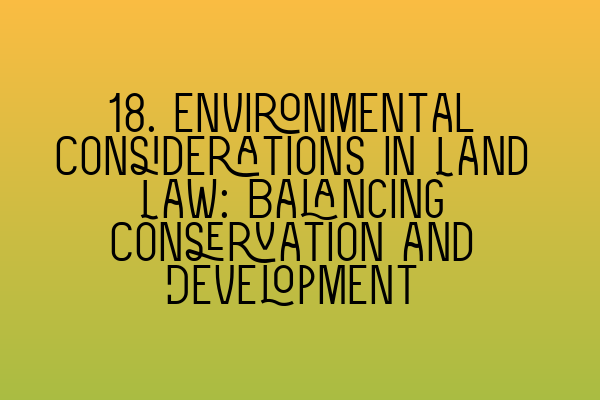Environmental Considerations in Land Law: Balancing Conservation and Development
Land law encompasses a wide range of legal principles and regulations that govern the ownership, use, and transfer of land. In recent years, there has been a growing recognition of the importance of environmental considerations in land law, as society grapples with the challenges of balancing conservation and development.
Environmental considerations in land law are rooted in the understanding that the natural environment is a valuable and irreplaceable resource that must be protected for the benefit of current and future generations. This recognition has given rise to a range of legal frameworks and principles aimed at ensuring sustainable land use and protecting the environment.
One important aspect of environmental considerations in land law is the preservation of natural habitats and biodiversity. Landowners have a duty to protect and preserve ecologically significant areas on their property, such as wetlands, woodlands, or rare species habitats. This duty extends to both public and private landowners, and there are legal mechanisms in place to regulate and enforce these protections.
Conservation easements, for example, are legal agreements that restrict certain activities on a property in order to protect its ecological value. These easements can be voluntarily entered into by landowners, or they can be imposed by government agencies or conservation organizations. They serve as a powerful tool for balancing conservation and development, allowing landowners to maintain ownership of their property while also ensuring its long-term ecological integrity.
Another important consideration in land law is the regulation of land use activities that can have a detrimental impact on the environment. Activities such as mining, logging, or the construction of large-scale infrastructure projects can have significant environmental consequences, including habitat destruction, pollution, and greenhouse gas emissions.
Government authorities play a crucial role in regulating these activities and ensuring that they are carried out in a manner that minimizes environmental harm. Environmental impact assessments, for example, are a common regulatory requirement for certain types of development projects. These assessments evaluate the potential environmental impacts of a proposed project and help inform decision-making processes.
Additionally, land law also addresses the issue of contamination and pollution of land. Industrial activities, chemical spills, and improper waste disposal can all lead to the contamination of land and groundwater, posing health risks and environmental hazards. Legal mechanisms, such as remediation orders, can be utilized to require responsible parties to clean up contaminated land, ensuring that it is safe for human use and protecting the surrounding environment.
While the preservation of the environment is of paramount importance, it is essential to strike a balance between conservation and development. Land is a limited resource, and society requires land for various purposes, including housing, infrastructure, and economic development. At the same time, it is crucial to ensure that these activities are carried out in a sustainable manner that minimizes negative impacts on the environment.
Land law recognizes this balance and incorporates mechanisms such as zoning regulations, land use planning, and environmental impact assessments to ensure that land is used efficiently and responsibly. These mechanisms help guide development activities to areas that are suitable and minimize adverse environmental impacts.
In conclusion, environmental considerations are integral to land law and play a crucial role in balancing conservation and development. The preservation of natural habitats, regulation of land use activities, and addressing contamination are just a few examples of the ways in which environmental considerations are integrated into land law. By incorporating these considerations into legal frameworks, society can strive towards sustainable land use that protects the environment while also meeting societal needs.
Related Articles:
